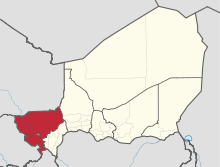Tillabéri Region
| Tillabéri | |
|---|---|
| Region | |
 Location within Niger | |
| Coordinates: 14°13′N 1°27′E / 14.217°N 1.450°ECoordinates: 14°13′N 1°27′E / 14.217°N 1.450°E | |
| Country |
|
| Capital | Tillabéri |
| Government | |
| • Governor | Youssoufa Mamadou Maiga (2011-Present) |
| Area | |
| • Total | 89,623 km2 (34,604 sq mi) |
| Population (2011[1]) | |
| • Total | 2,572,125 |
| • Density | 29/km2 (74/sq mi) |
| Time zone | West Africa Time (UTC+1) |
Tillabéri (var. Tillabéry) is an administrative Region in Niger; the capital of the Region is Tillabéri. Tillabéri Region was created in 1992, when Niamey Region was split, with the area immediately outside Niamey renamed as the capital district.[2]
Geography
The region of Tillabéri is bounded to the north by the Republic of Mali, to the east by the regions of Tahoua and Dosso, to the south by Benin and to the west by Burkina Faso. The urban community of Niamey is landlocked by the region as well. The region has a large network of watershed including the Niger river and several seasonal (known as Gorouol, Sirba) and permanent (known as Mékrou, Tapoa) watercourses. The W National Park of Niger is located in the extreme south of the region and extends to Burkina Faso and Benin. The northwestern part of the region (Ouallam and Filingué) have a savannah type flora and fauna.
Climate
The region has a hot and relatively humid climate with 540 mm of rainfall in Niamey. However it does not receive a drop of rain for over four months a year, and rainfall is erratic.
Divisions and borders

Tillabéri is divided into 6 departments:
- Filingue Department
- Kollo Department
- Ouallam Department
- Say Department
- Téra Department
- Tillaberi Department
Tillabéri has the following foreign borders, including Niger's only border with Burkina Faso:
- Gao Region, Mali - north
- Oudalan Province, Burkina Faso - west, north of Séno
- Séno Province, Burkina Faso - west, south of Oudalan and north of Yagha
- Yagha Province, Burkina Faso - southwest, south of Séno and north of Komondjari
- Komondjari Province, Burkina Faso - southwest, south of Yagha and northwest of Tapoa
- Tapoa Province, Burkina Faso - south, southeast of Komondjari
- Alibori Department, Benin - southeast
Domestically, it borders the following departments:
- Dosso Region - east
- Tahoua Region - northeast
Tillabéri also surrounds the capital district of Niamey.
Economy
The economy of the region of Tillabéri is based primary on agriculture, livestock and fishery production. However, Tillabéri is rich in mineral resources (gold and iron ore) and increasingly becoming attractive for future mining investments. In 2004, the first gold mine in Téra began operation. In addition, the region of Tillabéri has great touristic potential with W Park, the Niger river and many more attractions.
Agriculture, livestock and fishery
Based on data from the National Statistics Institute of Niger, The region of Tillaberi is 1st producer of riz (5,700 tonnes), 5th for sorghum (40,900 tonnes), 5th for millet (39,9400 tonnes), 3rd for corn (1,100 tonnes), 5th for black-eyed pea (15,3000 tonnes) and 5th in peanut (2,400 tonnes) in 2011 among regions.[3] It is also an important livestock producer and the 1st producer of cattle with recorded 2087 thousand cattle heads in 2011.[4] Although the Niger river is crossing through this region, it is only the 3rd producer of fishery products with 637 thousand tonnes in 2011.[5]
Mineral mining
The region of Tillabéri is home to the Samira Hill Gold Mine in Tera. In addition to gold, the region is rich in iron ore with estimated reserves of 650 million tonnes in Say.[6]
Gold mining
In 2004, long well-known gold deposits in Téra resulted in the first gold mine in Niger, the Samira Hill Gold Mine. The mine was partly owned by the government of Niger (20%) and a Canadian/Moroccan consortia.
Tourism

The region of Tillabéri has many tourist sites. One of these sites is the W National Park of Niger which is classified as a World Heritage by UNESCO. The park which is co-managed by Benin and Burkina Faso, offers a wide variety of fona and flora on side located in Niger. There are 15 touristic sites in the region according to Government publications: 5 in Flingué, 4 in Kollo, 2 in Ouallam, 1 in Say, 2 in Téra and 1 in Tillabéri. The region has a modest hospitality infrastructure with only 2 4 star hotels and 137 rooms (42 rooms for the 4 star hotels).[7]
See also
References
- ↑ Annuaire statistique du Niger
- ↑ According to Statsoid: "~1992: Tillabéry Region split from Niamey (whose FIPS code was NG05 before the change). Status of Niamey changed from Region to capital district."
- ↑ Annuaire statistique du Niger - Agriculture
- ↑ Annuaire statistique du Niger - Eleveage
- ↑ Annuaire statistique du Niger - Peche
- ↑ Niger Mining
- ↑ - Tillaberi
| ||||||||||||||||||||||||||||||||||